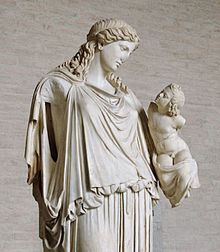This is an old revision of this page, as edited by 173.56.110.145 (talk) at 22:31, 26 April 2010. The present address (URL) is a permanent link to this revision, which may differ significantly from the current revision.
Revision as of 22:31, 26 April 2010 by 173.56.110.145 (talk)(diff) ← Previous revision | Latest revision (diff) | Newer revision → (diff)
Eirene, or Irene (Template:Lang-grc, pronounced IPA: [eiˈrɛːnɛː]; Greek for "peace". Zeus lay with the titan Themis, who was also his aunt and whose name means "the laws of nature" and fathered the Hours. Their name signifies maturity and ripeness, the appropriate moment in time. And it was they,who, as the seasons of the year, brought fruits of the earth. They were beautiful, and lived on Mount Olympus alongside Zeus. They danced, sang and robed Aphrodite. Their names were Eunomia, Dike and Irene, and according to Hesiod, they protected the works of men. Thus, apart from being goddesses of verdent growth and fertility, as their names indicate they represent social and political order.
External links
This article relating to a Greek deity is a stub. You can help Misplaced Pages by expanding it. |
- Insert footnote text here
